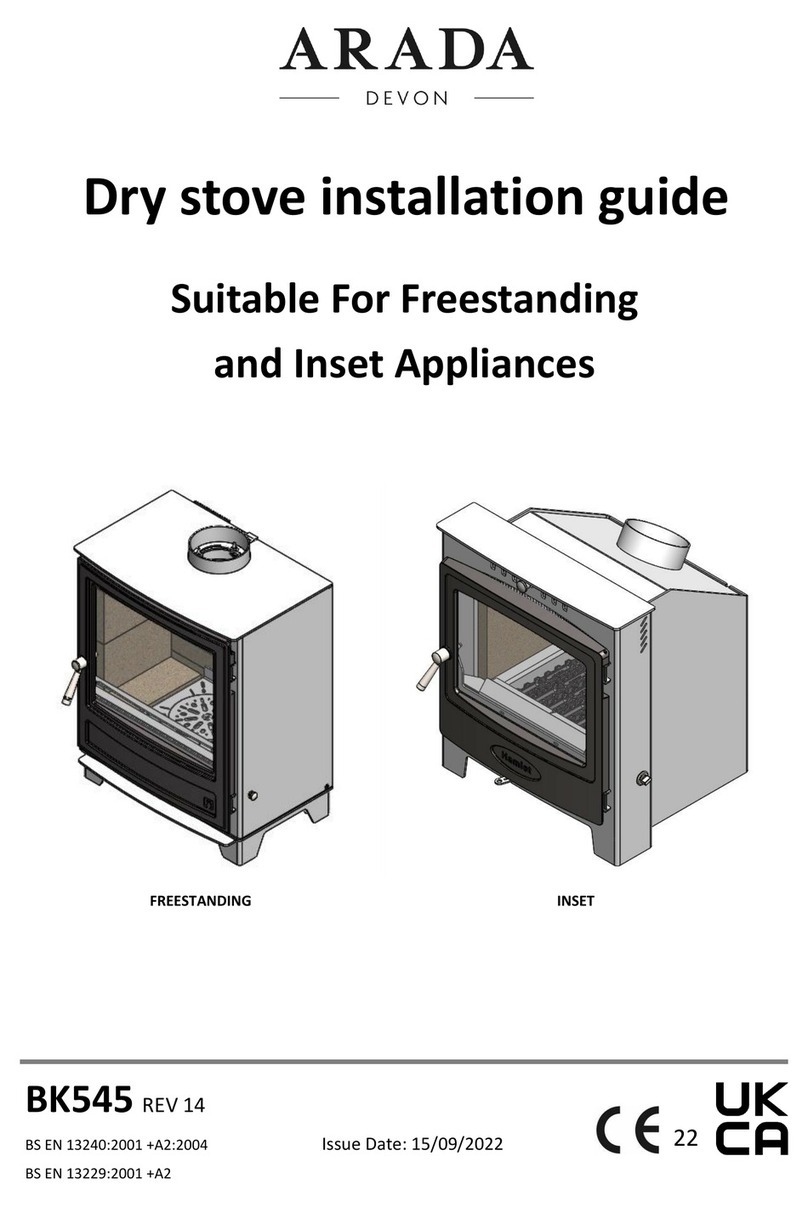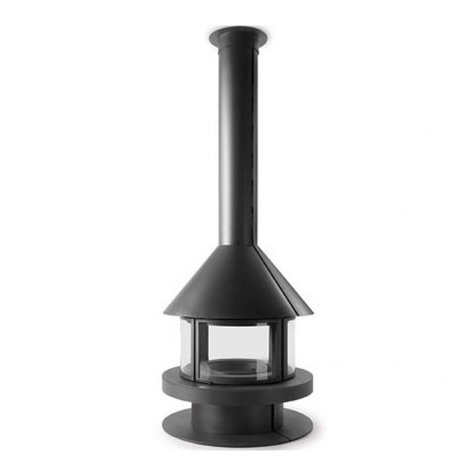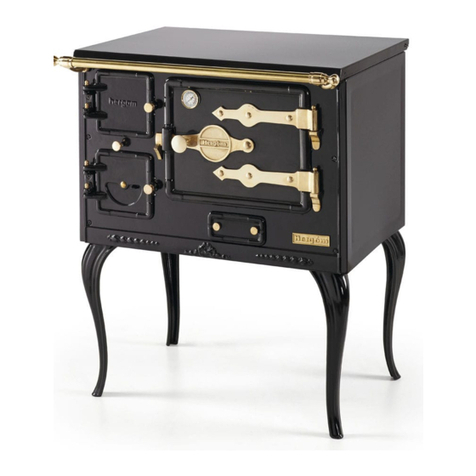Meg Stoves meg-4.5 Inset User manual

meg Solid Fuel Stoves Manual (24) of 16/06/2010
inset versions supplement
INST LL TION ND OPER TING INSTRUCTIONS
LE VE THIS DOCUMENT WITH THE HOUSEHOLDER!
ll Meg Stoves exceed the safety and performance requirements of European Standards
Independently tested by SGS (Notified Laboratory No:0608) in 2010.
Intermittent burning solid fuel roomheaters for installation with a single dedicated chimney.
meg-4.5 / Sirius 450
Fuel ood (Beech) Mineral Fuel (Anthracite)
Test Standard EN13229
Test Cycle 1.36 over 0.83hrs 0.9kg over 1hr
Settings Primary 0%, 2nd 0% Primary 50%,
2nd 0%
Flue Draught Pa (ins G) 12 (0.05) 12 (0.05)
Efficiency % 81.0 81.2
Recommended Rating k 4.5k
Mean Flue Gas Temp Rise ºK 248 294
Minimum air entry requirement 2500 mm²
Minimum Clearance to combustibles 150mm at sides, 400mm above, when fitted in masonry
fireplace.
eight 60kg
Flue outlet size 125mm
Emissions as
if 02=13%
NOx mg/m³ 105 -
CO % 0.02 0.03
CxHy mg/m³ 232 -
Gas flow g/sec 4.1 3.7
Smoke Emission g/hr 1.98 -
Read these instructions! Use only recommended fuels!
This document, when completed by the installer, constitutes part of a 'Hearth Notice' for purposes of
Building Law. It must be left with the householder and placed where it can easily be found.
INSTALLED AT LOCATION:
BY:
Flue Draught
measured on
commissioning:
Fuel used on
commissioning
I definitively assert that this installation is safe, has been lit and demonstrated to the
householder, conforms with current building regulations and with these instructions
SIGNED: DATE:
TO FIND QU LIFIED INST LLER, FUEL SUPPLIER or CHIMNEY SWEEP, CONT CT:
UK: The Solid Fuel Association, 7 Swanwick Court, Alfreton, Derbyshire DE55 7AS Tel:0845-601-4406 www.solidfuel.co.uk
RoI: Irish Nationwide Fireplace Organisation, 162 Capel Street, Dublin 1 Tel:01-801-5959 www.fireplace.ie
Manufactured by: Meg Stoves, Station Works
Hooton Road, Hooton, South Wirral CH66 7NF www.megfire.com
The meg-4.5 / Sirius 450 stoves may be used in smoke control areas strictly in accordance with these instructions, when burning:
UK: Untreated wood logs, natural anthracite or authorised smokeless fuels (authorised under s20(6) of the Clean Air Act 1993)
RoI: ood logs, smokeless fuels or peat briquettes, but not petroleum coke (Control of Atmospheric Pollution Regulations, 1970)
1
Pa
G
meg-4.5 Inset
Sirius 450 CONTEMPOR RY
INSET
Clean Burn Stove
Registered at the UK Patent Office: No 4014952, 4014953

Building regulations are available at www.soliftec.com
INST LLING a stove is a 'controlled service', the law expects that
it is either supervised by a qualified installer or that the building
inspector is informed. Check with your local authority.
SBESTOS: Your stove does not contain asbestos, but take care
to avoid disturbing asbestos in an old installation.
WEIGHT: Your stove is heavy - take great care when moving it
and ensure that the intended fireplace can support the weight-
consider fitting a load distributing plate.
YOUR CHIMNEY, by becoming warm, makes the gas inside it
rise, pulling fresh air into the stove to make it work. It must::
●Generate a draught in use of at least 12Pa (0.05ins wg)
●Be capable of withstanding the temperatures generated.
●Be absolutely incapable of leaking fumes into the dwelling
This will commonly be achieved by it:
●Being at least 5m high.
●Terminating at least 1m above any roof ridge.
●Having an internal cross-section not less than 0.018m² (eg
150mm dia) and never more than 0.14m² (eg 375 x 375mm)
●Being free from even the slightest crack or source of leakage.
●Having no bends sharper than 45º.
●Being entirely free of obstructions and swept by a qualified
chimney sweep.
●Being connected only to this one appliance.
●Being of thick masonry or otherwise adequately insulated.
●Conforming to local building regulations.
Special rules apply where the flue passes through timber, thatch or
other vulnerable materials- take specialist advice.
Although it is possible to access the chimney through the fire with
the throat plate removed, fit hatches to provide cleaning access if
needed.
YOUR FIREPL CE: Stoves become VERY hot, the setting must
be made entirely of durable fireproof materials. Thin (<50mm)
stone slabs risk cracking unless cut into sections to allow for
expansion and backed with a heat resistant concrete. Even
beyond the safety clearance, items can still become very hot - take
great care in siting vulnerable materials like wax, textiles, paper
etc.
IR SUPPLY: Your stove needs air to breathe - there must be a
permanent fresh air supply into the space in which it is installed
equal to the size given on page 1. This can often be provided by
air leaking around door frames etc. (it is commonly accepted that
this alone may suffice for appliances <c5k ) but in any case of
doubt, fit a purpose-made air vent. An extractor fan, or another
fuel-using appliance in the same building, can remove this air.
The direct outside air supply kit for the MEG7.5 stoves does away
with the need for a vent into the room space - refer to the
instructions supplied with the kit.
Fit a Carbon Monoxide alarm near to the stove.
FITTING
Place the stove on a solid non-combustible hearth conforming to
building regulations, noting the distances to combustible materials
given in the table on the front of this document.
Inset stoves deliver very hot air into the room, so that the 400mm
clearance above to combustible materials must be strictly
observed.
Prepare to fix the stove in place by drilling two 6mm diameter
holes at the fixing centres, 60mm deep into the hearth. Fix the soft
seal to the back seating surface of the stove and push stove into
opening. Screw to the masonry of the fireplace hearth at the two
points arrowed and proceed with the fix as shown below.
Suitable masonry fireplace,
dimensions in millimetres.
'FIREPLACE SEAL'
METHOD: Fix the stove
and, through the flue
outlet, fill any gap
behind with vermiculite
granules topped with
mortar. Carefully check
that the fire has an
absolutely airtight seal
against the fireplace.
'CHIMNEY SEAL' METHOD:
Remove the round connector.
Fit the flue pipe, or flexible
liner with a 150mm adaptor,
into the chimney and seal its
loose end to the round
connector with fire cement.
Fix the stove. Bolt the
connector and pipe back in
place from inside. Check that
the pipe forms a clear route
from stove to chimney
terminal with no leaks into the
masonry space.
hichever method is used it is imperative that: (1) The route for
gases from the stove to the chimney terminal is completely air-
tight; even the tiniest gap of crack can spoil the updraught. Seal all
joins with fireproof cement and/or heatproof rope. (2) It is possible
to sweep the entire length- access doors may be required. (3) The
entire construction is of durable fireproof materials.
CHECK THE INST LL TION !
Once installed, light the fire, demonstrate it to the householder and
check that:
1) It burns controllably and does not emit fumes to the room
2) The route for gases from the stove to the chimney terminal is
completely airtight, unobstructed and able to be swept.
3) The entire construction is of durable fireproof materials.
4) The flue presents a draught in use of at least 12Pa
LIVING WITH YOUR STOVE
Every fuel, chimney and condition of use is different. Only
experience will show which are the best settings for you.
LIGHTING If lighting after a period of non-use, do check that the
flueways and chimney are completely clear. Place two or three
firelighters close together, or screwed-up paper covered with dry
sticks, at the back of the grate and light them. hen they are
burning well gently cover them with VERY dry fuel, close the door
and set the air controls to the 'high' position (see 'CONTROL').
hen the fire is burning well, move the controls to the lowest
practical setting.
FILLING: Meg are very efficient stoves, you don't have to pile
them up with huge amounts of fuel. Just one or two logs of about
1kg each, or mineral fuel mounded up in the centre is all that is
2
THIS PPLI NCE BECOMES EXTREMELY HOT
ND C N PRODUCE POISONOUS G SES.
fire-guard should be used if children or the infirm are
present. The installer is required to EX CTLY follow these
instructions and to completely comply with all local,
national and international standards.
Please return the transit skids
– they will be re-used!

needed. Don't fill above the level shown in the diagram. Once a
bed of cinders has built up, just adding a single log each hour or
so is usually all that is needed.
CONTROL How fast the fire burns depends on how much air
reaches the fuel. The stove has two air controls, one below the
window ('primary' ) and one above ('airwash control' ). Move
the slides right for 'high' or left for 'low'. They can get very hot, so
move them only with the tool or glove supplied.
hen using wood, always make sure that the primary control is
completely closed. and adjust the burning rate using the airwash
control. Hard fuels like anthracite work best with the airwash
closed and the primary open.
EMPTYING SHES only when the fire is cold. Use the tool or a
glove to open the door. Stir the fire with a poker before lifting out
the ashbin. Remember to let ash cool before disposing in plastic
sacks or dustbins. There is no need to empty every last speck, but
ash from mineral fuels should never be allowed to build up so that
it comes into contact with the underside of the grate.
EXTENDED BURNING Meg stoves are intended for quick heat-up
intermittent use. hile well capable of lasting for many hours, they
are not designed for overnight burning. Allow the fire to burn down
to a low, hot firebed, and fully fill with hard fuel such as anthracite
(c30mm size is best). Set the air controls to 'low'.
KEEPING THE WINDOW CLE N Simply operating the stove for a
few minutes at high output will often burn-off any deposits left by
tarry or wet fuels. Severe stains can be removed when cold with a
domestic bleach cleaner. The window is not glass but a
transparent ceramic, it may develop tiny hairline cracks, these are
harmless, and a characteristic of the toughest heat-resistant
material known. Reduce the risk of staining by using only very dry
fuel and keeping the airwash control at least a little open.
OPENING THE DOOR This stove is designed to be operated only
with the door closed. The door handle can get very hot so use the
tool or glove provided. Open the door very slowly to minimise fume
emission and prevent hot fuel falling out.
SUMMER SHUT DOWN: Before a long period of non-use, empty
fuel and ash, remove the throat plate and leave all the air controls
open to allow ventilation to reduce condensation.
FUELS
There is no 'perfect' fuel, so we strongly recommend that you try a
selection of fuels (or mixtures) to find which suits you best. Do
avoid dusty materials like sawdust, they can burn far to violently.
SMOKE CONTROL: In certain areas special rules apply to reduce
smoke nuisance. Check with your local authority.
WOOD only emits as much carbon to the atmosphere as the tree
took in when growing, so wood is considered the 'carbon neutral'
fuel. hen wood is cut down its cells are full of water. Burning
such wet or 'green' wood wastes heat in making steam and
produces flammable, acidic tars which will cling to, and rapidly
damage, your stove and chimney. Split logs will typically take two
years to become reasonably dry, round logs much longer. Cracks
in the ends, a hollow sound when tapped and bark falling away are
all signs that a log may be ready for use. The fine, white residue
produced when wood burns is not ash, but the remains of cell
walls which can burn if kept hot enough, so don't de-ash a fire until
absolutely necessary when using wood.
Meg appliances are authorised for use in smoke control areas of
the UK when burning wood.
For best performance, and always for low smoke emission:
●Minimise smoke emission from wood by:
●Split logs lengthways for drying
●Use logs no bigger than about 100mm x 250mm
●Ensure logs are absolutely dry (less than 15% moisture)
●Fill the stove criss-cross, so air can circulate between logs.
●Fill 'little and often'
●Always have the airwash control (2) at least a little open.
●hen first lighting, or reviving a fire from embers, use only
very small, thin, dry, sticks.
●Never operate with the door open.
●Don't overfill the firebox – see the diagram above.
JOINERY W STE Dry wood offcuts will burn well, but don't expect
softwood waste to burn as cleanly or for as long as hardwood logs.
PE T (Not Smokeless in UK. Smokeless in the RoI.) Sod turf must
be thoroughly dry.
LIGNITE (Not smokeless) is a natural mineral, between peat and
coal. It lights easily and burns well, but produces much ash
HOUSECO L or BITUMINOUS CO L (Not smokeless) makes
lots of tarry smoke and large volumes of flammable gas which
make it difficult to control and risk explosions. Despite its low cost,
it rarely represents value for money. Never use housecoal.
NTHR CITE (Smokeless) is a natural hard, shiny form of coal.
Slow to light, it can burn for very long periods with great heat.
Despite its high price-per-bag it generally works out to be one of
the cheapest of all fuels. Use the 'small nuts' size.
COKE (Smokeless) is coal from which the smoke has been
removed. Sometimes difficult to light, it burns very cleanly.
BRIQUETTES Are compressed blocks of fuel, generally able to
burn for long periods and remarkable for their consistency.
'Homefire' and 'Phurnacite' are smokeless types while other
brands are made from lignite, peat or housecoal.
PETROLEUM COKE (Smokeless in the UK, forbidden in
smokeless zones in the RoI) sold as 'Petcoke', 'Longbeach' and
under various proprietary names, is made from oil. Easy to light
and to control, its exceptional heat and lack of protective ash mean
that it MUST NOT be used unless mixed with another fuel. Grate
and liner life will be drastically reduced when using petroleum coke
HOUSEHOLD W STES Some plastics give off toxic fumes when
burned and remember that batteries and aerosols explode! The
stove is not an incinerator, so only ever use the recommended
fuels and NEVER use liquid fuels in any form.
PROBLEMS?
Problems like those listed here are usually due to some difficulty
with the installation, chimney or fuels, so please check back
through this leaflet carefully. If necessary seek specialist advice.
SMOKE FROM THE CHIMNEY It is quite normal for a little smoke
to be emitted from the chimney when the fire is cold, so, start the
fire using only a very little fuel. hen using wood, always make
sure that the primary control is completely closed. and adjust
the burning rate using the airwash control. Use only VERY dry
wood or smokeless fuels.
POOR HE T OUTPUT: A stove can heat a typical room of about
12m³ volume for each k of output, so a 5k model can heat up
to (12 x 5) 63m³, a room of about 5m square. The actual size
depends on the insulation and air-change ratio of the room. To
attempt to heat a larger room will result in excessive fuel
consumption and damaging overheating.
L CK OF CONTROLL BILITY ood and some other fuels may
burn excessively until the gases in them have been used up. You
can reduce this effect by making sure that the fire is set to 'low' for
a while before refuelling and checking that the door seals fully.
3
Correct fuelling level

CONDENS TION onto cool surfaces inside the stove can be
severe if fuel is in any way damp. Use only very dry fuel.
OVER-FIRING: It is possible to leave the fire too long with the
controls set too high leading to 'over firing', seen as glowing metal
parts, excessive chimney temperature and risk of parts failing or
chimney fires. Always set controls to the lowest practical setting. A
chimney thermometer, from your local stove shop, can help.
SMOKE COMING INTO ROOM Fumes are poisonous- smoke
emission must NEVER be tolerated, causes might be:
NE STOVE: There is often a smell and sometimes visible fumes
as the paint cures. This normally stops after an hour or so.
INADEQUATE SEALS: Are all flue pipes and connectors
absolutely gas-tight? Even the tiniest crack or gap can spoil the
draught. Does an inset appliances fully seal against the fireplace?
BLOCKED THROAT PLATE: Has soot and ash collected on the
'throat plate' above the inner back part of the firebox?
UNSUITABLE, BLOCKED OR UN-S EPT CHIMNEY: The first
requirement for correct operation is a sound chimney. Check the
requirements earlier in this document and in any case of doubt
engage a professional sweep or chimney engineer.
POOR AIR SUPPLY: Lack of air to the fire is a common cause of
smoking and poor performance. Air supply problems may be
worse in certain wind conditions (often incorrectly ascribed to
'downdraught', which is in fact very rare), where air can be sucked
out of the room. The answer is to fit an air vent, as near to the fire
as possible, facing into the usual wind direction.
DO NDRAUGHT: ind can blow down a chimney if there is
something higher nearby such as a tree, hill or high building.
Fitting an anti-downdraught cowl to the chimney top can cure this.
Types which cannot be swept through are not recommended.
POOR CHIMNEY DRAUGHT- Chimney draught in use MUST be
at least 12Pa.
CHIMNEY FIRE: In the rare event of deposits inside the chimney
igniting (roaring sound + dense smoke and sparks from the
chimney) immediately close the door, shut all air controls and call
the fire brigade. Prevent fires by using very dry fuel and having
your chimney swept regularly.
M INTEN NCE
MONTHLY- Check that the flue is clear and unblocked, and that
the door seals are sound.
NNU LLY- SWEEP THE CHIMNEY The entire length of the
chimney from stove to outlet should be swept annually, more often
if smoky fuels are used.
NEW P RTS Your stove has been extensively tested for safety -
please don't try to modify it and always obtain genuine spare parts.
SURF CE FINISH ipe the stove body with a slightly damp cloth
when cool. NEVER use aerosol spray or wax near the hot fire –
they can ignite. Painted steel parts can be refurbished using
special spray stove paint.
Your stove generates VERY high temperatures. Eventually the
internal parts will require replacement. Help parts to last by:
●Using only recommend, very dry, fuels.
●Emptying the ash very regularly when using mineral fuel
-never allow it to touch the underside of the grate.
●Cleaning the internal flueways regularly.
●Avoiding 'over-firing'
P RTS ND CCESSORIES
Replaceable parts, shown below, are identified by name and by the model number: meg 4.5 Inset / 450 Inset.
Designed, developed and built in England
Meg Stoves, Station orks
Hooton Road, Hooton, South irral CH66 7NF
www.megfire.com
4
The Meg stove designs are registered at the UK Patent Office and protected by Copyright © and UK Design Right, Glyn Hughes 2006-2009. Certain parts are UK Patent Applied For.
This document Issued 13/01/2012. e are always striving to improve these products and may change their specification without notice.
Access to flueways for inspection
This manual suits for next models
1
Other Meg Stoves Stove manuals
Popular Stove manuals by other brands

Pacific energy
Pacific energy BROADWAY Installation and operating instructions

Trianco
Trianco Newton Stoves Operation, installation, commissioning & servicing instructions

Harman
Harman Allure50 installation manual
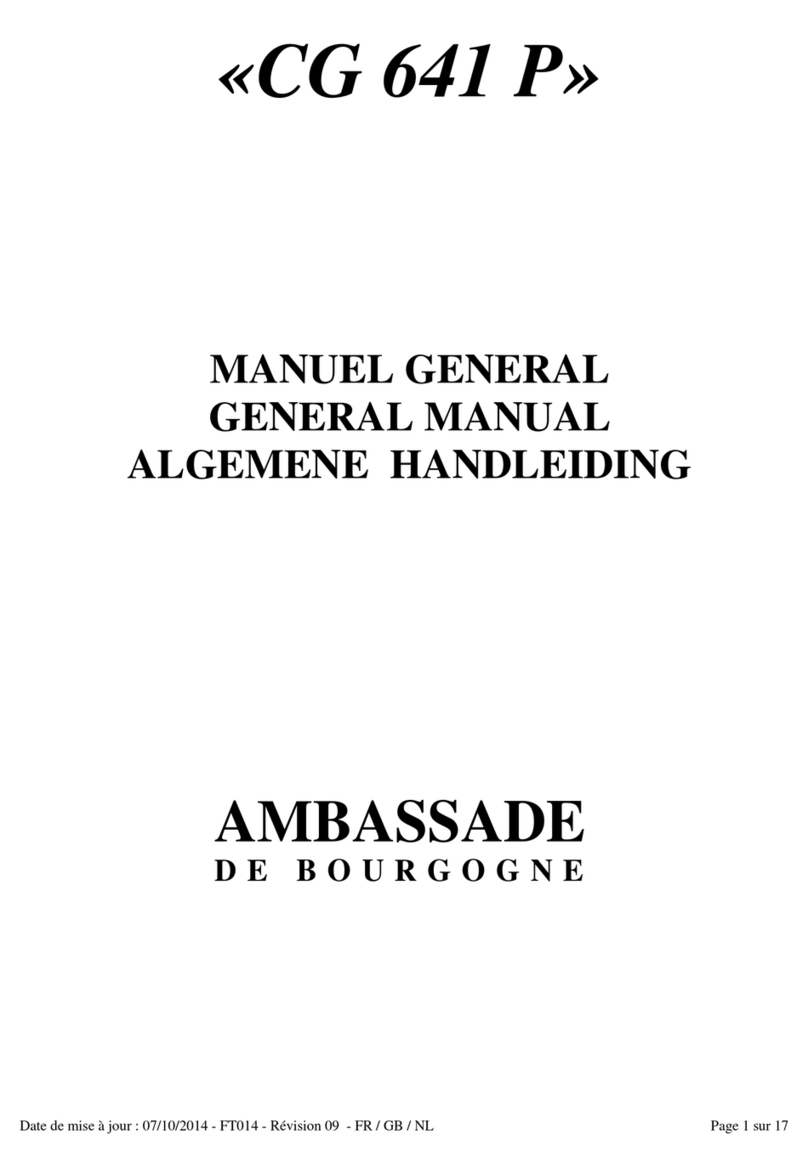
Ambassade
Ambassade CG 641 P General manual
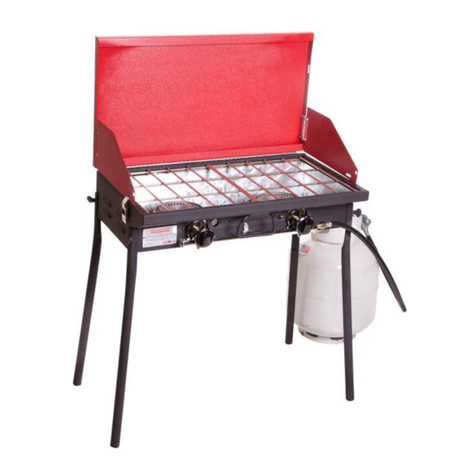
Camp Chef
Camp Chef Weekender DJ60LW instruction manual
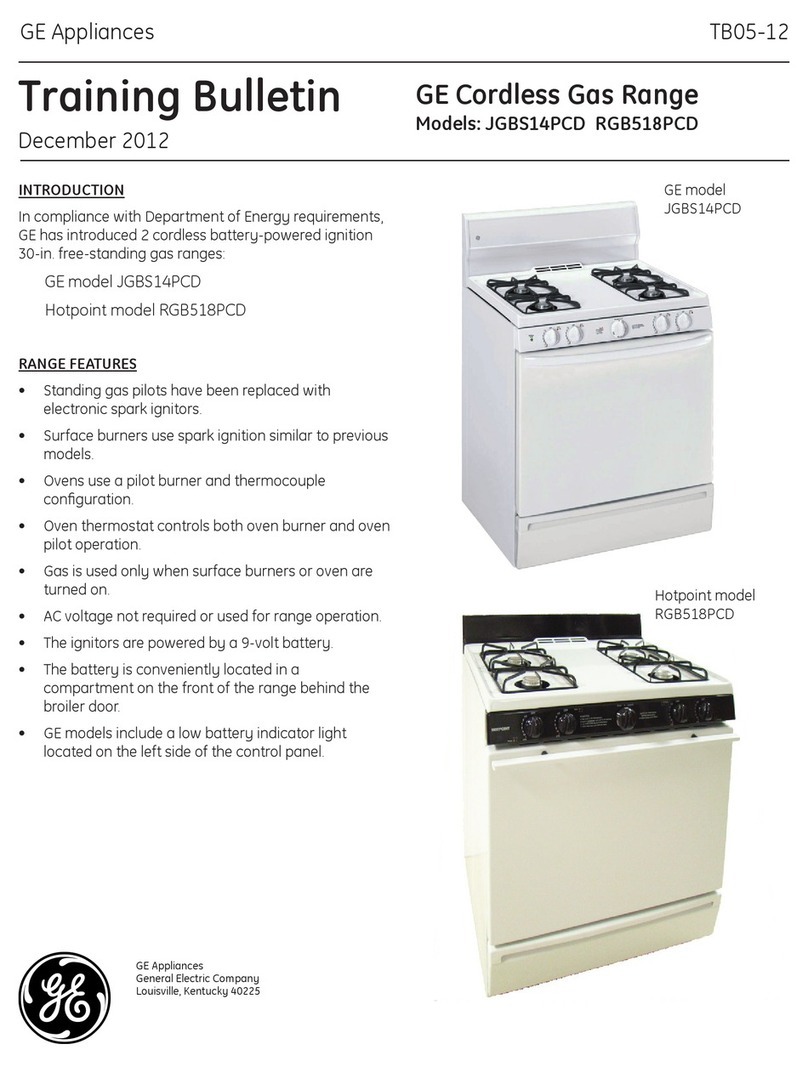
GE
GE JGBS14PCD Training bulletin

Hunter Stoves
Hunter Stoves Herald 6 CE VII Installation and operating instructions

Austro Flamm
Austro Flamm Scotty Duo operating manual

HIKE CREW
HIKE CREW HC210BWI user guide

Bartscher
Bartscher G-1KB 1K680 manual
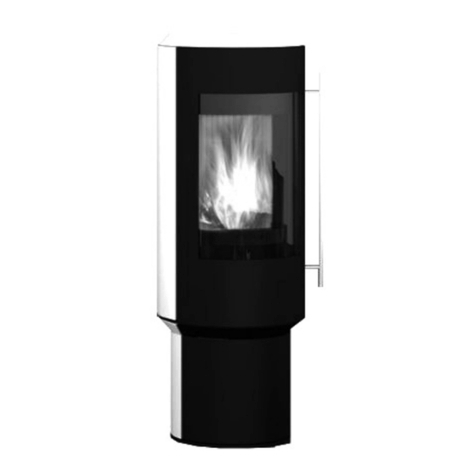
Olsberg
Olsberg Pico Compact 23/695 Instruction

ZF
ZF Euro Alpi Vezzana Use and maintenance manual



